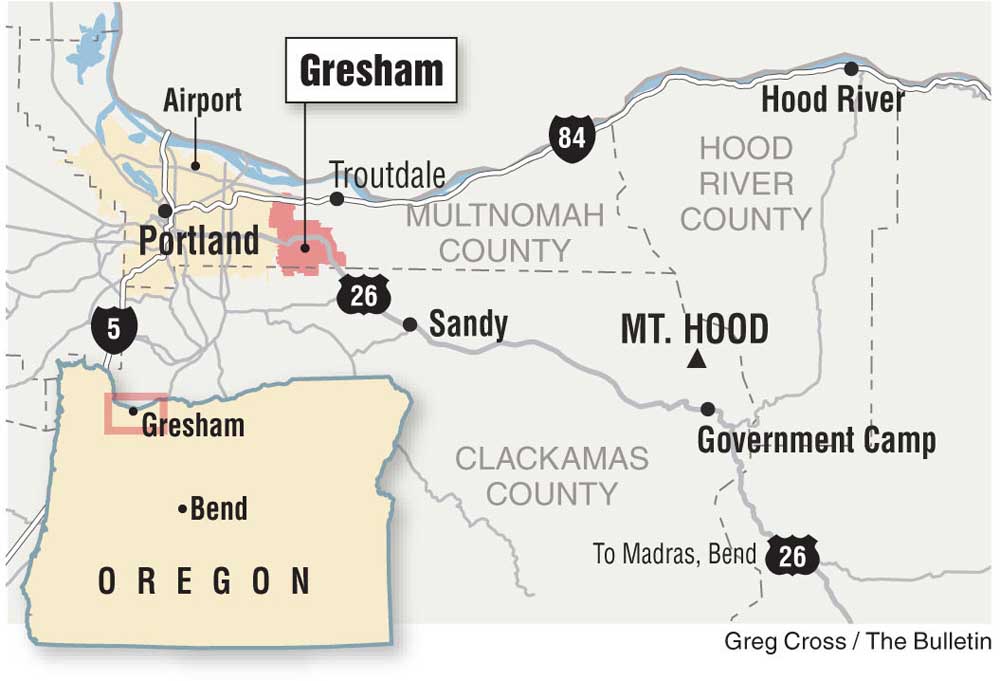Northwest Travel: Gresham shines in Portland’s shadow
Published 12:00 am Sunday, July 17, 2016

- Northwest Travel: Gresham shines in Portland’s shadow
GRESHAM —
One of Portland’s most charming neighborhoods isn’t in Portland at all.
Trending
Historic Old Town Gresham lies only about 17 miles east of Oregon’s largest city, but it’s a world apart. Oregon’s fourth-largest city — its population of 110,000 is exceeded only by Portland, Salem and Eugene — sprawls east along U.S. Highway 26 (Powell Boulevard) from 162nd Street to the foothills of Mount Hood.
Abutting the smaller towns of Troutdale, Fairview, Wood Village and Damascus, Gresham is known as the home to Mt. Hood Community College and as an ideal hub for driving the Mount Hood Scenic Byway loop road: It sits near the western edge of the historic Columbia River Highway and is a mere 45-minute drive from Timberline Lodge on Mount Hood.
And while it is a bedroom community for many Portland workers (the TriMet Max Line provides light-rail service day and night), Gresham has a identity of its own. Homes on Gresham Butte glance north across the Powell Valley to the broad Columbia River, where Interstate 84 links Portland International Airport to the waterfall country of the Columbia Gorge Scenic Area. And in the heart of it all is the historic downtown.
Heart of downtown
Main Avenue, whose heart runs for eight blocks from Powell Boulevard north to Division Street east of 223rd Avenue, is the center of action. Here are a variety of retail outlets and galleries, restaurants and lounges quite independent of those that fill suburban malls. Especially between Powell and NE Fourth Street, shops like Feather Your Nest and Accent on Attitude, and eateries like Cafe Delirium and Boccelli’s Ristorante, beckon visitors.
Annual events such as last weekend’s Gresham Arts Festival and the Soroptimist Teddy Bear Parade (this year on Sept. 24, and bring your own teddy bear) keep things hopping. There are regular street-rod cruises and a Third Thursday event each month, and farmers markets set up a half block west of Main Avenue on Third Street every Saturday through September.
Trending
At Center for the Arts Plaza, two blocks east of Main Avenue between Second and Third streets, a concert plaza and a pair of children’s fountains (one of them designed for toddlers) make summer a busy season. Four pillars on the north side of the plaza, designed by Seattle artist Claudia Fitch, are said to represent visual art (a paintbrush), music (a trumpet), literature (a fountain pen) and dance (a tutu).
But the pride of downtown Gresham is its Carnegie Library, a 1913 structure listed on the National Register of Historic Places. The national Andrew Carnegie fund built the structure to support the city library, which had begun as a bookshelf in Gresham’s pioneering general store. After the library’s burgeoning collection was moved to a new, larger building in 1989, the Gresham Historical Society assumed ownership and restored it to its original, ornate, Tudor Revival-style appearance.
Music and arts
Today the old library is the city’s historical museum, with changing exhibits on subjects of special interest to local citizens. Currently those include memories of the Mt. Hood Jazz Festival, held on the community college campus for more than two decades beginning in 1982. Musical giants such as Dave Brubeck, Tito Puente and B.B. King were among those who performed at the festival, which drew crowds of more than 10,000 in its halcyon years as a forerunner to the annual Portland Jazz Festival.
The biggest visitor draws at Mt. Hood Community College these days are its Black Swan Theatre and its planetarium, which offers one-hour, public Sky Theatre shows on the first Tuesday evening of each month (at 6 and 7:15 p.m.).
As for music, several restaurant lounges on Main Avenue offer regular performances — notably Spinella’s off the wall, which welcomes local musicians Thursday through Saturday nights to its showroom in the 1928 Zion Evangelical Church, just north of the old library.
And the flagship property of the McMenamins group, Edgefield, is practically around the corner from Gresham. Wedged between Troutdale and Fairview, the onetime Multnomah County poor farm is a revelation to anyone who hasn’t yet discovered it.
Edgefield has a multitude of low-cost lodging and dining options; a brewery, winery and distillery; a spa and soaking pool; gardens, a movie theater and an abbreviated golf course on its 38 acres. The summer outdoor concert series, which next introduces the Avett Brothers on Thursday and Friday, later this month will feature Willie Nelson, Weezer and a Jerry Garcia birthday party on July 31.
City of parks
South of Powell Boulevard, immediately opposite downtown, Main Avenue slips downhill into Gresham’s 21-acre Main City Park. Here you’ll find a “Heroes Memorial” — honoring firefighters and police officers who have given their lives, along with wartime casualties — as well as a skate park, an off-leash dog park, sports fields and Tsuru Island.
Tsuru Island is a Japanese garden that was born of Gresham’s sister-city relationship with Ebetsu, Japan. Three-fourths of an acre in size, flanked by Johnson Creek (which surrounds it in high water), it has a brand-new pavilion near a stone-and-moss turtle reached by winding paths and an arcing bridge. Originally designed by the Japanese-American Citizens League of Gresham-Troutdale in 1975 and given the Japanese name for crane (“tsusu”), the pretty park was rescued from neglect by volunteers and reopened two summers ago.
The Springwater Corridor — a paved 21-mile trail that follows a former rail line along Johnson Creek, a Willamette River tributary, through Gresham en route from Portland to Boring — skims the south side of Main City Park. This was the original rail link to Gresham when the town was young, and it operated until 1958, when a new line was built along Burnside Road farther north.
The Gresham portion of the corridor, which passes the city’s old Pioneer Cemetery and extends west to the historic Linneman Station trailhead, was completed in 1996, with the full network as it now stands finished about 10 years later. Urban designers speculate that it might someday be extended to link with the Pacific Crest Trail at Government Camp.
Main City Park is one of an astonishing 53 Gresham city parks totaling well over 300 acres. And that doesn’t include Oxbow Regional Park, itself a 1,000-acre reserve that nestles around a double loop in the meandering Sandy River several miles east of the city.
Oxbow’s 67-site campground, 12 miles of trails through old-growth cedar forest, a boat launch for rafters and kayakers, and sterling steelhead and salmon fishing from shore beckon outdoors lovers of all manners. A rich wildlife population welcomes photographers as well.
A little history
The Gresham area was first settled in 1852 by brothers James and Jackson Powell, Oregon Trail pioneers who homesteaded under the terms of the Donation Land Claim Act of 1850. When they were joined the following year by unrelated X Powell, the farm region became known as Powell’s Valley.
Over the next generation, other families populated this valley and surrounding districts that grew into the communities of Troutdale, Fairview, Sandy, Damascus, Boring and Estacada.
Gresham’s first post office, which served the area for 13 years beginning in 1871, was dubbed “Camp Ground,” acknowledging its importance as an overnight stop for travelers en route to Portland. The new post office, established in 1884, was named for U.S. Postmaster General Walter Quinton Gresham, a Civil War hero who later served as secretary of state from 1893 to 1895 in the second Grover Cleveland administration.
The town was formally incorporated as Gresham in 1905 during Portland’s Lewis and Clark Centennial Exposition, a year after the election of its first mayor (Lewis Shattuck) and City Council, and two years after the inauguration of interurban streetcar service. The 36-mile line from Sellwood, in southeast Portland, ran through Gresham to Estacada, increased from twice-daily to hourly within a year on the 17-mile Gresham run, as population began to swell, reaching 1,000 by 1910.
From its early years, Powell’s Valley was prized for its farmland. Berries were (and continue to be, on a smaller level) a prime crop, along with grapes and vegetables. The town’s growth was initially slow; as recently as 1960, population still stood at about 4,000. But then it exploded — to 10,000 by 1970, 33,000 by 1980 and 90,000 by 2000. Gresham has now passed Beaverton and Hillsboro as Portland’s largest suburban city.
The environs
Of towns in the immediate vicinity, Troutdale (with about 16,000 population) is perhaps the most notable. Situated where the Sandy River pours into the Columbia northeast of Gresham, it was known through the last half of the 20th century as the home of Reynolds Aluminum.
Once the third-largest aluminum company in the world, Reynolds operated from 1941 — when it was established to provide military metal for World War II troops — until it was acquired by Alcoa in 2000 and closed. Adjacent Wood Village was built as a company town for plant workers, and Reynolds High School still bears the company name.
Downtown Troutdale today boasts three blocks of colorful, modern wood-and-stone buildings on either side of a wide boulevard just off I-84, leading east from a Columbia River gateway arch. Just beyond the east end of this strip, the Troutdale Rail Museum preserves a 1907 Union Pacific depot. Down the hill toward the Sandy River, the Harlow House Museum preserves the circa-1900 home of Fred Harlow, the son of Captain John Harlow, credited with founding the town in 1882.
More grand, perhaps, is the Zimmerman House, farm and gardens, located on the Columbia floodplain in northwest Gresham, east of the Portland airport. Built in 1874, the farmstead remained in the Zimmerman family until 1992, when the East County Historical Organization took over its maintenance. In addition to restoring the house — open for visits every Saturday afternoon in summer, once a month the rest of the year — ECHO is developing the surrounding Heritage Farm Historical Park and Gardens as an educational facility to demonstrate late 19th-century farming techniques.
Like Gresham itself, it’s a little-known but readily accessible treasure on the east side of Oregon’s largest city.
— Reporter: janderson@bendbulletin.com.








